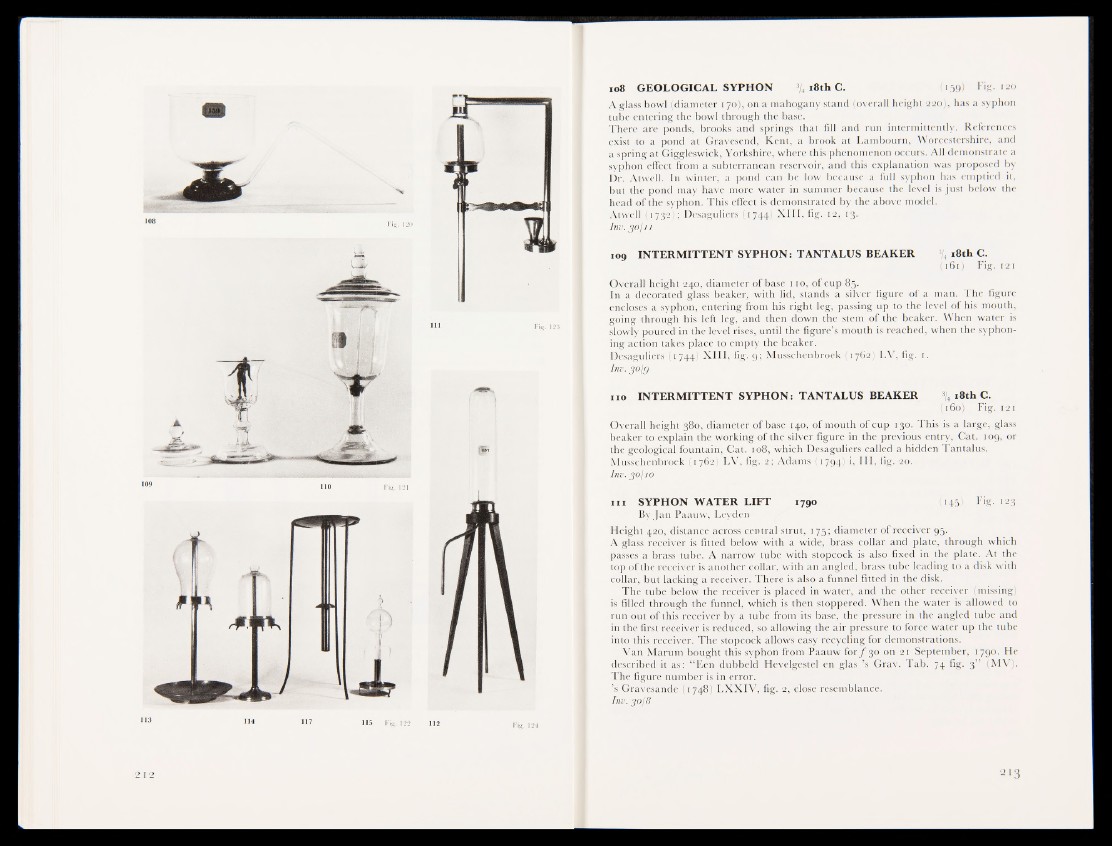
io8 GEOLOGICAL SYPHON % 18th C. (159) * ig 120
A glass bowl (diameter 170), on a mahogany stand (overall height 220), has a syphon
tube entering the bowl through the base.
There are ponds, brooks and springs that fill and run intermittently. References
exist to a pond at Gravesend, Kent, a brook at Lambourn, Worcestershire, and
a spring at Giggleswick, Yorkshire, where this phenomenon occurs. All demonstrate a
syphon effect from a subterranean reservoir, and this explanation was proposed by
Dr. Atwell. In winter, a pond can be low because a full syphon has emptied it,
but the pond may have more water in summer because the level is just below the
head of the syphon. This effect is demonstrated by the above model.
Atwell (.1732); Desaguliers (1744) XIII, fig. 12, 13.
Inc. jo in
109 INTERMITTENT SYPHON: TANTALUS BEAKER 3/4 18th C.
(161) Fig. 121
Overall height 240, diameter of base 110, of cup 85.
In a decorated glass beaker, with lid, stands a silver figure of a man. The figure
encloi#|StJteyphon, entering from his right leg, passing up to the level of his mouth,
going through his left leg, and then down the stem of the beaker. When water is
slowly poured in the level rises; until the figure’s mouth is reached, when the syphoning
action takes place to empty the beaker.
DesaglllierSffl744) XIII, fijglg; Musschenbroek (1762) LV, fig. 1.
Ina^Ul0.
n o INTERMITTENT SYPHON: TANTALUS BEAKER % 18th C.
(160) Fig. 121
Overall height 380, diameter of base 140, of mouth of cup 130. This is a large, glass
beaker to explain the working of the silver figure in the previous entry, Cat. 109, or
the geoggical fountain, Cat. 108, which Desaguliers called a hidden Tantalus.
MulSchenbroek (1762) LV, fig, 2; Adams (1794) i, III, fig. 20.
Inv. go; 10
i n SYPHON WATER LIFT 1790 (145) Fig. 123
Byjan Paauw, Leyden
Height 420, distance across central strutM75; diameter of receiver 95.
A glass receiver & fitted below with a wide, brass collar and plate, through which
passes a brass tube. A narrow tube with stopcock is also fixed in the plate. At the
top of the receiver is another collar, with an angled, ’brass tube leading to a disk with
collar, but lacking a receiver. There is also a funnel fitted in the disk.
The tube below the receiver is placed in water, and the other receiver (missing)
is filled through the funnel, which is then stoppered. When the water is allowed to
run out of this receiver by a tube from its base, the pressure in the angled tube and
in the first receiver is reduced, so allowing the air pressure to force water up the tube
into this receiver. The stopcock allows easy recycling for demonstrations.
Van Marum bought this syphon from Paauw for f 30 on 21 September, 1790. He
described it as: “Eeri dubbeld Hevelgestel en glas ’s Grav. Tab. 74 fig. 3” (MV).
The figure number is in error.
’s Gravesande (1748) LXXIV, fig. 2, close resemblance.
Inv. 30I8